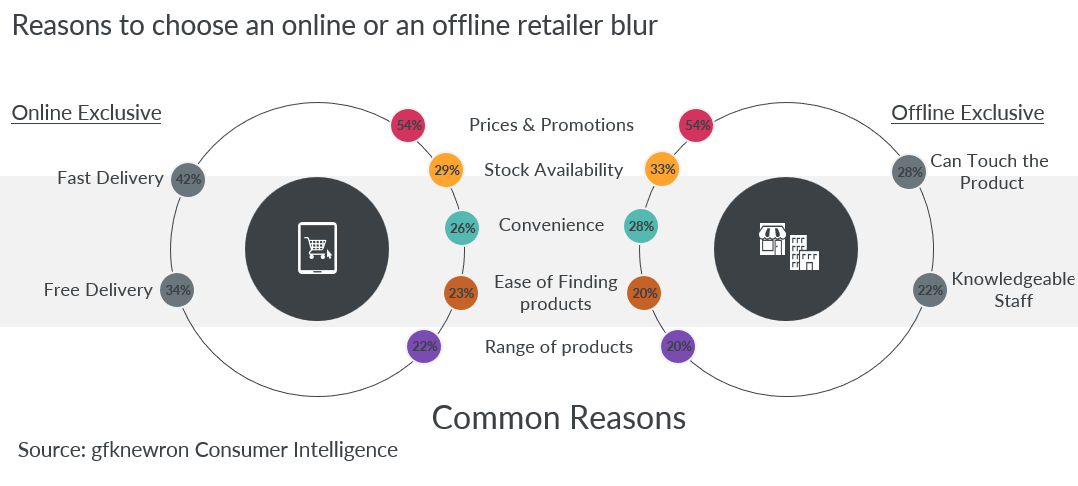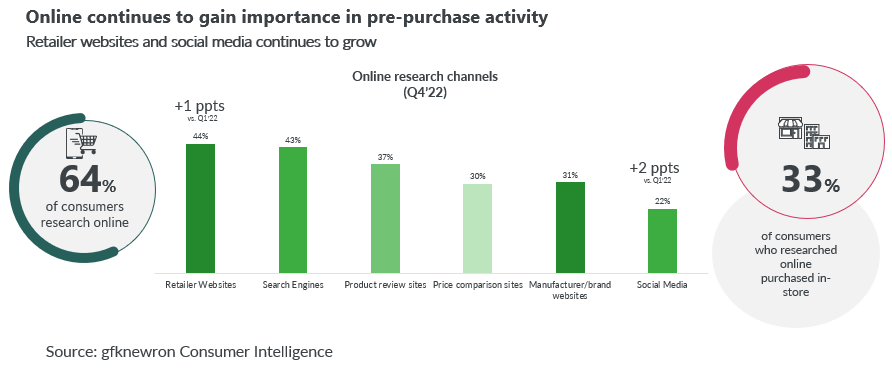Growing up in a period of radical technological and societal change has resulted in younger generations having vastly different expectations and behaviors than those that have come before. By 2030, Millennials and Gen Z will likely outnumber Baby Boomers. These are the first generations to grow up with the internet, smartphones and social media as well as wider societal movements such as sustainability.
As well as shifting demographics, Covid-19 accelerated some key transformations in society. Hybrid working is increasingly the norm and expected by younger jobseekers who feel comfortable with managing all aspects of their lives remotely. This trend is also reflected in online shopping’s elevated popularity, which has so far remained above pre-pandemic levels – suggesting a long-term change in consumer behavior.
Innovation is driving shifts in consumer expectations, enhancing buying journeys, and improving sustainability in this sector. While many retailers are harnessing innovation to better meet their customers’ preferences, others are not adapting quickly enough to the dramatic shifts in experiences the next generation demands.
So, what should retailers consider to take full advantage of this evolving landscape?
Omnichannel is a necessity
The internet has transformed the path to purchase, making omnichannel not just an option, but a necessity. 64% of consumers research potential products online, using retailer websites, search engines, price comparison sites and, increasingly, social media. They may research a particular product using social media and price comparison websites before heading into a physical store or a generalist platform like Amazon or Shopee to hunt for the best deals.
One of the main reasons consumers cite for choosing an online retailer is access to prices and promotions (54%), and they are willing to conduct their own research to find them. People are also much more aware of the promotional calendar with events like Black Friday, and are willing to wait for the best deals. By harnessing the data gathered through omnichannel journeys, retailers can deliver personalized loyalty programs that answer people’s desire to get the best deal possible, all year round.
The metaverse also offers a potential wealth of opportunities to inspire consumers during the buying journey. Early leaders in this space are already beginning to make their products more interesting for tech savvy consumers through gamification. Others are rewarding their most loyal clients with NFTs that allow them to access special promotions or features.

A growing channel to embrace: social selling
Of all the channels, one is rising in prominence: social media. Customers are increasingly using social media as part of the product research process, so retailers should be looking to turn that research into sales through content that shows products in action.

Not only does social media provide a way for brands to increase engagement during the research phase and with existing customers, social platforms are also increasingly introducing shopping touchpoints. Features like TikTok Shop and Instagram Shop as well as live streaming platforms are enabling consumers to move straight from research to purchase.
We are already seeing the impact of social selling in economies around the world. In China, for example, social selling has taken off in a big way and the market is expected to reach 4.9 trillion in 2023. Live stream commerce is expected to account for 10% of total retail sales in the country.
Creating a more seamless experience
While this multitude of channels and touchpoints may seem complex, in reality it contributes to a more seamless customer experience. Live stream and social media shopping platforms are removing barriers for consumers, helping to boost sales and reduce issues like abandoned carts.
The appeal of generalist marketplaces is the ability to reduce purchases down to a single click instead of having to manually fill in delivery or payment information each time. In fact, 90% of the top 10 global marketplaces are generalist, offering a simplified buying process for a wide range of product types. The use of digital wallets and contactless payments also continues to grow worldwide, driven largely by China and India. 62% of global consumers prefer this method of payment.

This ability to enhance the customer experience extends beyond payments. Many consumers value being able to go into a store and talk to an expert, which is reflected in the figures – 33% of actual purchases are made in store. Retailers are now replicating this service online, too. For example, through advanced chatbots or being able to book video calls with in-store experts.
We are already seeing a range of innovative new retail experiences emerging, such as product lounges or pilot testing stores. The growth in popularity of the metaverse in particular offers another route for retailers and brands to offer new kinds of consumer experiences.
Add-ons including insurance, installation, and interest-free credit are also becoming increasingly common for larger or more complex purchases, such as technology and household goods. These services act as seamless support, extending the shopping experience beyond the point of payment.
Prioritize sustainability
Along with following their own omnichannel journeys, younger consumers also increasingly value sustainability and buying with a purpose. There are a number of steps retailers can take to tap into this preference.
Firstly, consumers as well as governments and investors increasingly want more transparency about the environmental or social impact of the products they buy. Providing sustainability metrics and marketing the environmental features of products in store and online can help consumers make more informed decisions and nurture loyalty. Retailers can also harness the in-store and remote experts discussed previously to cultivate awareness about impact and explain to customers which products best align with their footprint goals. The challenge will be communicating sustainability credentials without greenwashing, something that consumers are increasingly conscious about.
Secondly, a growing number of companies are designing enhanced repairability or circularity to increase the lifecycle of their products. Retailers can make it easier for their customers to reduce their own footprints through repair hubs, recycling collection points and collaborations with businesses that sell second-life products. Again, in-store experts can highlight which products can be repaired and enable circularity.
As global demographics continue to shift over the coming decade, retailers need to be ready to adapt to the elusive opportunity of sustainability. Younger generations still want to interact with the brands they love and purchase great products. But their expectations around service and availability mean that retailers need to make sure they have the capabilities to deliver the right kind of experience.
Acknowledging change isn’t the same as understanding it and creating the right adaptation strategies. For that, you need the right data and insight.
![]()




